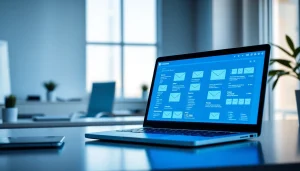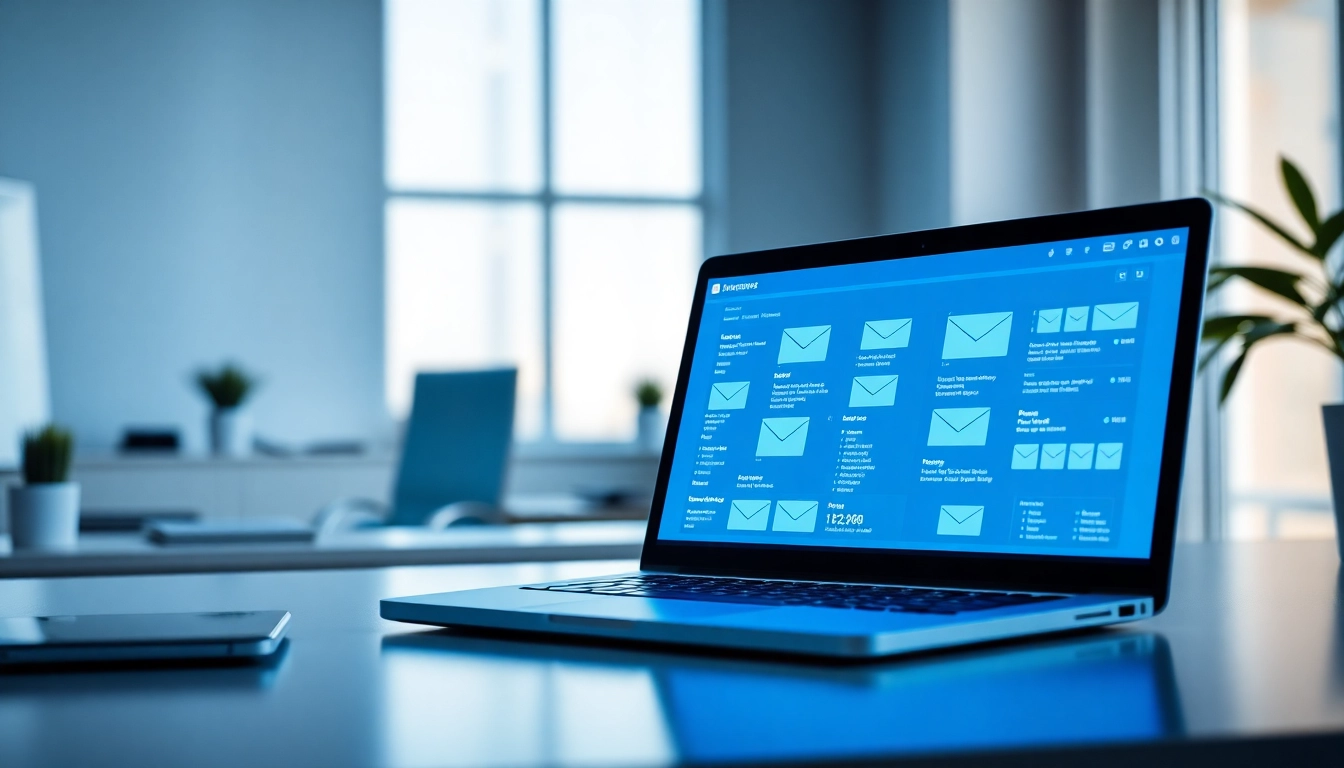Understanding Business Email Efficiency
What is Business Email Efficiency?
Business email efficiency refers to the optimal use of email communication within an organization to foster productivity and streamline workflows. It encompasses various strategies and practices that enhance the way teams communicate, manage their inboxes, and utilize email as a tool for collaboration and information sharing. In today’s fast-paced business environment, improving business email efficiency is crucial for successful operations and team alignment.
Common Email Management Challenges
Many organizations face common challenges regarding email management that hinder efficiency:
- Email Overload: Excessive emails can lead to information overload, making it difficult for employees to prioritize tasks.
- Poor Organization: A disorganized inbox can result in important messages being overlooked or lost.
- Lack of Standardization: Without consistent email practices, team members may have different approaches to handling emails, leading to confusion and miscommunication.
- Inefficient Response Times: Delays in responding to emails can affect project timelines and client relationships.
- Inadequate Training: Employees often lack training in effective email use, leading to miscommunication and wasted time.
The Importance of Email Communication in Business
Email is a cornerstone of modern business communication. It facilitates information exchange, enables collaboration on projects, and serves as a record of correspondence. The importance of efficient email practices lies in their capacity to enhance productivity, reduce stress among employees, and improve overall organizational communication. A well-managed email system can lead to better client interactions and support business objectives effectively.
Best Practices for Email Organization
Utilizing Folders and Labels for Clarity
A key method for improving email efficiency is to organize your inbox using folders and labels. By categorizing emails based on projects, departments, or urgency, employees can quickly locate important communications. Here are some best practices:
- Create specific folders for various projects or clients.
- Use color-coded labels to differentiate between types of communications.
- Implement a consistent naming convention for easy identification of folder contents.
- Encourage regular review and organization of folders to keep them relevant and up-to-date.
Implementing Automated Responses and Templates
Automating responses and utilizing email templates can save considerable time and enhance efficiency. Standard replies for common inquiries or status updates can free up valuable time for employees. Here’s how to effectively implement this practice:
- Identify frequently asked questions or common email scenarios that can benefit from templated responses.
- Create a library of email templates categorized by topic, making themeasy to access.
- Consider using autoresponders for messages that do not require immediate attention, informing senders when they can expect a response.
- Regularly review and update templates to ensure they remain relevant and effective.
Time Management Techniques for Email Handling
Effective time management techniques can greatly enhance email efficiency. Employees should consider incorporating the following strategies into their routines:
- The Two-Minute Rule: If an email can be answered in two minutes or less, respond immediately rather than postponing it.
- Set Specific Times for Checking Emails: Encourage employees to check their emails at designated times throughout the day rather than continuously, which can disrupt workflow.
- Prioritize Emails: Sort emails according to urgency and importance. This can be facilitated with the use of flags or priority markers.
- Batch Email Responses: Allocate time blocks for responding to emails, allowing for concentrated focus and increased productivity.
Advanced Tools to Enhance Email Efficiency
Exploring Email Management Software
Investing in robust email management software can significantly improve business email efficiency. These tools offer features such as email tracking, analytics, and integration with other platforms. Some highly recommended tools include:
- Outlook: Offers powerful organizational features including folders and rules.
- Gmail: Features like labels, filters, and an easy-to-use search function help manage emails effectively.
- Helpdesk Software: Solutions like Zendesk and Freshdesk help manage customer email inquiries efficiently.
- Email Analytics Tools: Such as Mixmax or Yesware allow tracking of email open rates, response times, and other key metrics.
Integrating Task Management with Email
Integrating task management tools with email can significantly streamline workflows. By linking emails with task management software, employees can ensure important actions are not overlooked. Here are some tips for integration:
- Use tools like Trello, Asana, or Monday.com that allow for seamless email-to-task conversion.
- Implement features that auto-generate tasks from emails, complete with deadlines and assigned team members.
- Train employees to regularly convert important emails into actionable tasks within their preferred management software.
- Encourage regular reviews of tasks generated from emails to ensure none are missed or forgotten.
Using Analytics to Track Email Performance
Data analytics can reveal insights into email performance, helping businesses understand areas of improvement. By using analytics, companies can track key metrics such as:
- Open Rates: Analyzing how many emails are opened can indicate the effectiveness of subject lines and timing.
- Response Times: Monitoring how quickly employees respond can help evaluate efficiency.
- Email Bounce Rates: High bounce rates may indicate issues with email lists that need addressing.
- Engagement Metrics: Tracking which emails receive the most interaction can refine future communication strategies.
Creating a Culture of Effective Email Use
Training Teams on Email Etiquette
Establishing a culture of effective email use requires training employees on email etiquette. This includes:
- Teaching proper subject line usage to clarify the purpose of the message.
- Encouraging concise and clear communication to respect the time of recipients.
- Emphasizing the importance of responding promptly, even if just to acknowledge receipt of an email.
- Fostering an understanding of when to use email versus other communication methods, such as phone calls or face-to-face meetings.
Establishing Email Response Protocols
Establishing clear protocols for email responses can improve organizational efficiency. Consider implementing the following:
- Define expected response times based on the nature of the email (e.g., urgent inquiries vs. general questions).
- Encourage employees to proactively inform senders if they need more time to provide a thorough reply.
- Set guidelines for using CC and BCC fields appropriately to avoid unnecessary clutter in inboxes.
- Regularly review and communicate any changes to response protocols to ensure everyone is on the same page.
Encouraging Regular Email Clean-Up
A key component of maintaining email efficiency is encouraging regular email clean-up. Organizations can adopt these habits:
- Encourage employees to dedicate time weekly or monthly to organize their inbox and delete unnecessary emails.
- Implement a policy for archival of old emails to reduce inbox clutter while ensuring access to valuable records.
- Create an internal challenge to engage employees in a company-wide email clean-up day.
- Provide tools or scripts that assist in automatically sorting and archiving outdated emails.
Measuring the ROI of Improved Email Practices
Key Metrics for Email Efficiency
Measuring the return on investment (ROI) for improved email practices involves assessing various metrics. Key performance indicators (KPIs) include:
- Reduction in email volume over time, indicating improved organization and efficiency.
- Enhanced employee productivity quantified by the number of tasks completed within a specific timeframe.
- Client satisfaction scores, reflecting the impact of responsive communication.
- Engagement levels during internal communications, showcasing improved team collaboration.
Analyzing Time Saved through Optimized Processes
Employees can save significant time through optimized email practices, which can be monitored by:
- Tracking average time spent handling emails before and after implementing efficiency strategies.
- Conducting employee surveys to assess perceived time savings and stress reduction values.
- Documenting the results of time management techniques, like batch processing emails.
- Calculating the time saved in project timelines due to actionable and clear communication.
Assessing Employee Satisfaction and Engagement
Employee satisfaction is critical in measuring the effectiveness of email strategies. Teams can gauge this through:
- Regular feedback sessions or surveys that specifically address email communication practices.
- Monitoring employee turnover or retention rates as an indirect measure of work satisfaction.
- Tracking productivity levels and their correlation to email efficiency enhancements.
- Creating focus groups that discuss email frustrations or suggestions for improvement.




















+ There are no comments
Add yours